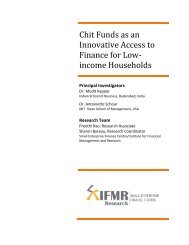Government of India Volume I: Analysis and Recommendations
Government of India Volume I: Analysis and Recommendations
Government of India Volume I: Analysis and Recommendations
You also want an ePaper? Increase the reach of your titles
YUMPU automatically turns print PDFs into web optimized ePapers that Google loves.
RESOLUTION<br />
<strong>and</strong> the tax payer arising from the risk <strong>of</strong> failure <strong>of</strong> a financial institution. However, there<br />
are important differences between the perspective <strong>of</strong> micro-prudential <strong>and</strong> resolution<br />
authorities in terms <strong>of</strong> timing <strong>and</strong> intensity <strong>of</strong> intervention. As long as a firm is healthy,<br />
the resolution authority does not intervene; <strong>and</strong> instead, relies on information from the<br />
micro-prudential regulator. At best, it conducts periodic reviews.<br />
As the probability <strong>of</strong> failure increases, the degree <strong>of</strong> supervision by the resolution<br />
corporation will increase. At each stage <strong>of</strong> greater difficulty, there will be regular interaction<br />
between the micro-prudential regulators <strong>and</strong> the resolution corporation. Microprudential<br />
regulators <strong>and</strong> the resolution corporation have a well defined protocol, embedded<br />
in the draft Code, for joint work covering:<br />
1. Risk assessment <strong>of</strong> covered service providers;<br />
2. Actions to be taken with respect to a covered service provider at different stages <strong>of</strong> risk to the<br />
covered service provider; <strong>and</strong><br />
3. Identification <strong>of</strong> emerging regulatory risks, their assessment, quantification <strong>and</strong> impact on the<br />
financial sector.<br />
The task <strong>of</strong> resolving a failing covered service provider also involves interaction with<br />
the competition regulator, CCI. One commonly used tool <strong>of</strong> resolution involves selling<br />
the firm to a healthy firm. In the routine business <strong>of</strong> selling or merging a firm, the effects<br />
on competition must be considered. The resolution corporation must consult the CCI on<br />
the likely effects <strong>of</strong> its actions on the state <strong>of</strong> competition in the market. In addition, the<br />
resolution corporation must prepare a report detailing the effect that its proposed action<br />
is likely to have on competition in the relevant market. The interaction should involve<br />
sharing <strong>of</strong> any relevant information <strong>and</strong> data at the disposal <strong>of</strong> the resolution corporation.<br />
However, in times <strong>of</strong> crisis, concerns <strong>of</strong> financial stability may outweigh competition<br />
concerns. An analysis <strong>of</strong> global experience shows that post-crisis, national competition<br />
authorities recognise that failing firm investigations are too lengthy, as firms in distress<br />
may deteriorate rapidly, <strong>and</strong> cause inefficient liquidations. Procedures need to be<br />
amended to facilitate speedy mergers <strong>of</strong> failing firms. In such an event, the obligation to<br />
consult the CCI <strong>and</strong> examine the implications on competition must be exempted.<br />
The resolution corporation must approach the FSDC in two circumstances. Firstly,<br />
if there is a difference <strong>of</strong> opinion between the resolution corporation <strong>and</strong> the microprudential<br />
regulator, either entity may approach the FSDC, which must resolve their dispute.<br />
Secondly, if the resolution corporation believes that it may be required to take action<br />
against a SIFI, it must necessarily inform the FSDC <strong>of</strong> the measures that it proposes to<br />
take thus, <strong>and</strong> seek permission for taking any such measures. The Commission is <strong>of</strong> the<br />
view that actions by the resolution corporation against a SIFI are likely to have systemic<br />
implications. The one entity in the new financial architecture designed by the Commission<br />
with a view <strong>of</strong> the entire system is the FSDC. Therefore, any actions against a SIFI<br />
must necessarily be with the knowledge <strong>and</strong> permission <strong>of</strong> the FSDC, to preempt any unforeseen<br />
systemic consequences from occurring.<br />
Table 7.3 establishes the framework <strong>of</strong> co-ordinated action with other agencies.<br />
7.5. Powers <strong>of</strong> the resolution corporation<br />
The Commission believes that the resolution corporation needs to be equipped with<br />
wide powers to carry out its functions. To carry out its supervisory reviews, the resolution<br />
corporation needs to have a specialised staff <strong>of</strong> examiners. These examiners will conduct<br />
regular examination <strong>of</strong> covered service providers. When the covered service provider<br />
shows unfavourable trends in its risk pr<strong>of</strong>ile, the resolution corporation can call for special<br />
examinations as a measure <strong>of</strong> enhanced supervision.<br />
FINANCIAL SECTOR LEGISLATIVE REFORMS COMMISSION 73



